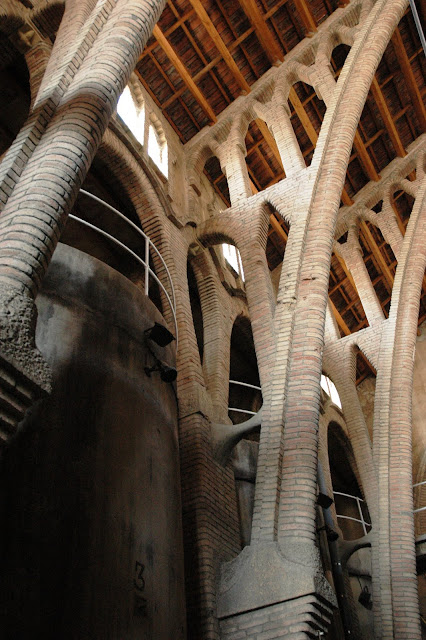 |
| Rocafort de Queralt |
Probably many of you will be acquainted with the works of Antoni Gaudì. In the first quarter of the 20th century he was the top Modernist (Art Noveau) architect in Catalonia, and designed beautiful, improbable buildings like La Pedrera or La Sagrada Familia, the unofficial icon of Barcelona.
 |
| Rocafort de Queralt |
 |
| Pinell de Brai |
In that same period the Catalan government (la Mancomunitat) promoted setting up farmers’ cooperatives. In many cases, the cooperatives erected their own buildings (cellers) to make wine and olive oil, and it became the fashion to employ the best architects of the time. The resulting cellers were unmistakably Modernist. Many of them have survived to date, and are regarded as “wine cathedrals” on account of their configuration and size. A typical layout is having one central, higher aisle flanked in some cases by two lower ones. Vats stand in these aisles, and presses and destemming equipment are placed where the altar might be. In the would-be crypts not bishops but oak barrels rest.
 |
| Pinell de Brai |
 |
| Pinell de Brai |
These magnificent buildings can be found mainly in the DOs of
Terra Alta (Gandesa, Pinell de Brai), Montsant (Falset),
Conca de Barberà (Espluga de Francolí, Sarral, Rocafort de Queralt, Barberà de la Conca, Pira, Montblanc),
Penedès and
Tarragona (Nulles). A few more are scattered over the rest of Catalonia, some of them in towns very close to Barcelona (Rubí, Sant Cugat del Vallès) where the agricultural past is far, far away. Some non-cooperative wineries have as well modernist buildings; the most interesting are
Codorniu (DO
Cava) and
Raimat (DO
Costers del Segre). My personal favourites? Pinell de Brai, Nulles and Espluga de Francolí. All three have undergone extensive restoration and can be seen at their best.
 |
| Pinell de Brai |
A first glace at their often fancy structures and embellishments may give the wrong impression that the artistic side had taken preeminence over the functional. Usually that is not the case, and the state-of-the-art winemaking technology of the time was used in the design and execution. (By the way, that also holds true about Gaudì’s work. However fantastic La Pedrera may seem, layout of the flats and internal structure are surprisingly modern and comfortable).
 |
| Espluga de Francolí |
 |
| Pinell de Brai |
Gaudì designed only one winery, in Garraf. The main figure in this field was one of his disciples, Cesar Martinell, who built more than forty of these edifices, and many other outstanding architects had celler design as one of their sidelines.
 |
| Pinell de Brai |
 |
| Espluga de Francolí |
Unfortunately the pioneering spirit is long gone from most cooperatives. Excepting a handful of cases, cooperatives are dominated by conservative majorities that do not want to take risks and fall back on traditional winemaking, with average to poor equipment and techniques and a lower quality range output. Sadly, the words “
Celler Cooperatiu” or “
Cooperativa” are not usually a signal of quality in a wine label. It is to be desired that cases like
Capçanes (DO
Montsant), that jumped into state-of-the-art winemaking with excellent results, encourage the rest to modernize and improve.
 |
| Espluga de Francolí |
In the meantime, a visit to any of these cellers as an architectural site is perfect to complement wine tasting in a good winery in the surroundings.
 |
| Pinell de Brai |
http://www.crcava.es/catala/flash.html
 |
| Pinell de Brai |













No comments:
Post a Comment